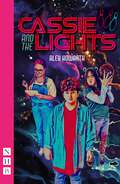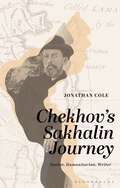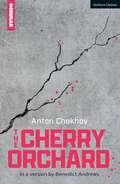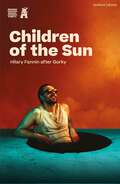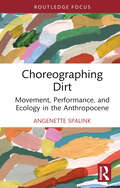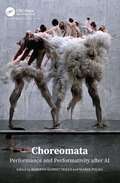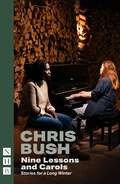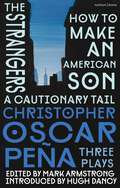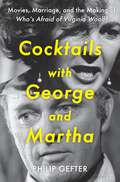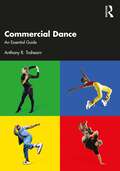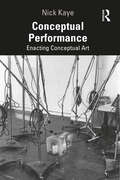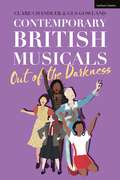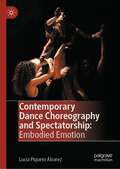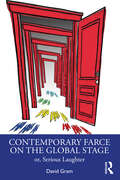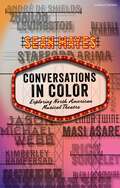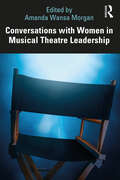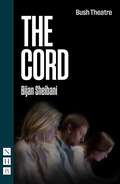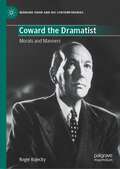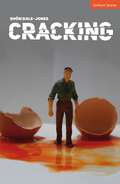- Table View
- List View
Cassie and the Lights (Nhb Modern Plays Ser.)
by Alex HowarthWhen her mother disappears, teenager Cassie wants to care for her sisters on her own. But can kids be parents? Or should Cassie let foster parents adopt her sisters and create a new family? Alex Howarth's play Cassie and the Lights is a tender and playful examination of what makes a family and what holds it together. Based on real-life events and interviews with children in care, it celebrates the resilience of young people and the power of sisterhood. The play has been performed at the Edinburgh Festival Fringe, VAULT Festival in London, 59E59 in New York City and Adelaide Fringe Festival in Australia. It toured the UK in 2024, produced by Patch of Blue and 3 hearts canvas, in association with Southwark Playhouse and Verse Unbound. 'Glows in the darkness… a thoughtful, warm, moving hour that will leave you wanting to call whoever you think of as family' - Guardian 'Bursts with life and quirkily observed truths' - The Stage
Chekhov’s Sakhalin Journey: Doctor, Humanitarian, Writer
by Jonathan ColeChekhov often said that 'I am a doctor by trade and sometimes I do literary work in my free time', a surprising claim, given his status as a giant of 20th century drama. This literary-biographical study uncovers new sides to him, as both a medical professional and humanitarian, and tells the story of Chekhov's trip to Sakhalin Island in the harsh wastes of Siberia.Anton Chekhov practiced medicine for most of his life and engaged in humanitarian work which took him away from writing for months. He placed one such trip though, across the unforgiving terrain of Siberia to write about the penal island of Sakhalin, above all others. Chekhov's Sakhalin Journey, written by a neuroscientist and practicing clinician, uses this trip and Chekhov's own account of it to shed light on hitherto overlooked aspects of his life. In doing so, it shows that to understand the man we need his medicine as well as his literature, and we need to assess his life from his perspective as well as ours.
The Cherry Orchard: In A New English Version (Modern Plays)
by Anton ChekhovThe orchard's white, all white. You haven't forgotten, have you, Lyuba? The avenue lined with trees, unfurling like a slender ribbon. And on moonlit nights, it shimmers. You remember, don't you? You haven't forgotten?Can anyone persuade Ranevskaya and her aristocratic household that the world is changing, and they must too?Following internationally acclaimed productions of The Seagull (Belvoir St Theatre, Sydney) and Three Sisters (Young Vic, London), director Benedict Andrews has a reputation as one of the world's leading interpreters of Chekhov. For the Donmar Warehouse he stages the great writer's final play. It's a work that predicted and captured the end of an era, but is timeless in its humanity, prescience, humour and pathos. The Cherry Orchard is Chekhov's masterpiece.This edition was published to coincide with its world premiere at London's Donmar Warehouse in April 2024.
Children of the Sun (Modern Plays)
by Ms. Hilary Fannin Maxim GorkyI am attempting to colonise the last frontier. Time, Elena, time. If we could inhabit different iterations of self, we could undo all the mistakes of the past. Don't you see?Hilary Fannin's radical adaptation of Maxim Gorky's classic 1905 dark comedy reworks the original text and draws it into the here and now. Children of the Sun is the story of a small family and their quixotic collection of acquaintances, entertaining and enraging each other while, unseen beyond their fragile walls, their world is being reshaped by unstoppable forces. The play asks how we survive without the benefit of hindsight and whether science, art or love are capable of saving us from uncertainty and destruction. Co-produced by Rough Magic and the Abbey Theatre, Children of the Sun premiered on the Abbey stage as part of Rough Magic's 40th-anniversary year in April 2024. This edition was published to coincide with that production.
Choreographing Dirt: Movement, Performance, and Ecology in the Anthropocene (Routledge Studies in Theatre, Ecology, and Performance)
by Angenette SpalinkThis book is an innovative study that places performance and dance studies in conversation with ecology by exploring the significance of dirt in performance. Focusing on a range of 20th- and 21st-century performances that include modern dance, dance-theatre, Butoh, and everyday life, this book demonstrates how the choreography of dirt makes biological, geographical, and cultural meaning, what the author terms "biogeocultography". Whether it’s the Foundling Father digging into the earth’s strata in Suzan-Lori Park’s The America Play (1994), peat hurling through the air in Pina Bausch’s The Rite of Spring (1975), dancers frantically shovelling out fistfuls of dirt in Eveoke Dance Theatre’s Las Mariposas (2010), or Butoh performers dancing with fungi in Iván-Daniel Espinosa’s Messengers Divinos (2018), each example shows how the incorporation of dirt can reveal micro-level interactions between species – like the interplay between microscopic skin bacteria and soil protozoa – and macro-level interactions – like the transformation of peat to a greenhouse gas. By demonstrating the stakes of moving dirt, this book posits that performance can operate as a space to grapple with the multifaceted ecological dilemmas of the Anthropocene. This book will be of broad interest to both practitioners and researchers in theatre, performance studies, dance, ecocriticism, and the environmental humanities.
Choreographing Dirt: Movement, Performance, and Ecology in the Anthropocene (Routledge Studies in Theatre, Ecology, and Performance)
by Angenette SpalinkThis book is an innovative study that places performance and dance studies in conversation with ecology by exploring the significance of dirt in performance. Focusing on a range of 20th- and 21st-century performances that include modern dance, dance-theatre, Butoh, and everyday life, this book demonstrates how the choreography of dirt makes biological, geographical, and cultural meaning, what the author terms "biogeocultography". Whether it’s the Foundling Father digging into the earth’s strata in Suzan-Lori Park’s The America Play (1994), peat hurling through the air in Pina Bausch’s The Rite of Spring (1975), dancers frantically shovelling out fistfuls of dirt in Eveoke Dance Theatre’s Las Mariposas (2010), or Butoh performers dancing with fungi in Iván-Daniel Espinosa’s Messengers Divinos (2018), each example shows how the incorporation of dirt can reveal micro-level interactions between species – like the interplay between microscopic skin bacteria and soil protozoa – and macro-level interactions – like the transformation of peat to a greenhouse gas. By demonstrating the stakes of moving dirt, this book posits that performance can operate as a space to grapple with the multifaceted ecological dilemmas of the Anthropocene. This book will be of broad interest to both practitioners and researchers in theatre, performance studies, dance, ecocriticism, and the environmental humanities.
Choreomata: Performance and Performativity after AI
Is artificial intelligence (AI) becoming more and more expressive, or is human thought adopting more and more structures from computation? What does it mean to perform oneself through AI, or to construct one’s subjectivity through AI? How does AI continue to complicate what it means to have a body? Has the golden age of AI, especially with regards to creative applications, already ended? Choreomata: Performance and Performativity after AI is a book about performance and performativity, but more specifically, it is a book about the performance of artificiality and the performance of intelligence. Both humans and human-designed computational forces are thoroughly engaged in an entangled, mutual performance of AI. Choreomata spins up a latticework of interdisciplinary thought, pairing theoretical inquiry from philosophy, information theory, and computer science with practical case studies from visual art, dance, music, and social theory. Through cross-disciplinary proportions and a diverse roster of contributors, this book contains insights for computer scientists, social scientists, industry professionals, artists, and beyond.
Choreomata: Performance and Performativity after AI
by Roberto Alonso TrilloIs artificial intelligence (AI) becoming more and more expressive, or is human thought adopting more and more structures from computation? What does it mean to perform oneself through AI, or to construct one’s subjectivity through AI? How does AI continue to complicate what it means to have a body? Has the golden age of AI, especially with regards to creative applications, already ended? Choreomata: Performance and Performativity after AI is a book about performance and performativity, but more specifically, it is a book about the performance of artificiality and the performance of intelligence. Both humans and human-designed computational forces are thoroughly engaged in an entangled, mutual performance of AI. Choreomata spins up a latticework of interdisciplinary thought, pairing theoretical inquiry from philosophy, information theory, and computer science with practical case studies from visual art, dance, music, and social theory. Through cross-disciplinary proportions and a diverse roster of contributors, this book contains insights for computer scientists, social scientists, industry professionals, artists, and beyond.
Chris Bush Plays: One (Nhb Collected Works)
by Chris BushSince her play Steel opened in her native Sheffield in 2018, Chris Bush has rapidly become one of the UK's most successful and widely staged playwrights, with her plays on stage at the National Theatre, in the West End, and across Europe. Celebrated for her spirited dissections of power, female agency, and northern identity, her work is infused with wit, empathy, and a powerful sense of place and belonging. Included here are five of her plays, all first performed between 2018 and 2021, together with a revealing introduction in which she reflects on the tumultuous period from which they emerged. Steel (Sheffield Theatres, 2018) is a political epic constructed from minimal resources, a two-hander spanning three decades of women in politics. 'Sharp, witty and uncannily topical' The Stage Faustus: That Damned Woman (Headlong, 2020) is a radical reimagining of the classic tale, asking what women must sacrifice to achieve greatness. 'Original, ambitious and fantastically revisionist' Guardian Nine Lessons and Carols (Almeida Theatre, 2020) is a play, with songs by Maimuna Memon, about connection and isolation, forged during the Covid pandemic, exploring what we hold on to in troubled times. 'A reminder of the power of theatre and our need for it' Telegraph Hungry (Paines Plough, 2021) is a pithy two-hander about food, love, class, and grief in a world where there's little left to savour. 'Reconfirms Chris Bush as one of our greatest, most relevant contemporary playwrights' Broadway World (Not) the End of the World (Schaubühne, Berlin, 2021) is a daringly theatrical investigation of the climate crisis through the perspectives of class, patriarchy, and colonialism. 'Staggering… Bush's remarkable text melds a ruthless structural concept with exquisite lyricism' Guardian 'One of our most prolific and arresting writers' Evening Standard 'A writer of great wit and empathy' The Times
christopher oscar peña: how to make an American Son; the strangers; a cautionary tail (Methuen Drama Play Collections)
by christopher oscar peña“Transcending 20th-century notions of race and culture, Peña's work succeeds in simultaneously touching our hearts, stimulating our minds, and examining our society.” - David Henry Hwang christopher oscar peña is a Latinx American playwright and screenwriter whose works frequently focus on stories that deal with bicultural identities, sexuality, and growing up in the modern world. In this first collected works, three of his plays are brought together, with an introduction by director Mark Armstrong. Together they offer a progressive and formally inventive collection of work to inspire theatre makers, actors and students alike. how to make an American Son: A “Model Immigrant” and business mogul, Honduran-born Mando's cleaning empire is bracing for a downturn at the exact same moment when he must rein in his over-privileged American son, Orlando. A moving coming-of-age comedy about the complexities of privilege, citizenship, sexual identity, and the most complex relationship of all: family. the strangers: Cris returns to a place he once used to know, only to find a world he no longer recognizes. As he connects with a new stranger tasked to show him around town, an unexpected spark challenges all of Cris' preconceived notions. a cautionary tail: First generation Chinese-Americans growing up in New York City, siblings Vivienne and Luke confront their confused tangle of family, their diverse array of friends, and their rampant sexuality. In our digital age, how can they navigate the traditional expectations of their mother with their American culture of individuality?
Cocktails with George and Martha: Movies, Marriage, and the Making of Who’s Afraid of Virginia Woolf?
by Philip GefterAn award-winning writer reveals the behind-the-scenes story of the provocative play, the groundbreaking film it became, and how two iconic stars changed the image of marriage forever. From its debut in 1962, Edward Albee's Who's Afraid of Virginia Woolf? was a wild success and a cultural lightning rod. The play transpires over one long, boozy night, laying bare the lies, compromises, and scalding love that have sustained a middle-aged couple through decades of marriage. It scandalized critics but magnetized audiences. Across 644 sold-out Broadway performances, the drama demolished the wall between what could and couldn't be said on the American stage and marked a definitive end to the I Love Lucy 1950s. Then, Hollywood took a colossal gamble on Albee's sophisticated play-and won. Costarring Elizabeth Taylor and Richard Burton, the sensational 1966 film minted first-time director Mike Nichols as industry royalty and won five Oscars. How this scorching play became a movie classic-surviving censorship attempts, its director's inexperience, and its stars' own tumultuous marriage-is one of the most riveting stories in all of cinema. Now, acclaimed author Philip Gefter tells that story in full for the first time, tracing Woolf from its hushed origins in Greenwich Village's bohemian enclave, through its tormented production process, to its explosion onto screens across America and a permanent place in the canon of cinematic marriages. This deliciously entertaining book explores how two couples-one fictional, one all too real-forced a nation to confront its most deeply held myths about relationships, sex, family, and, against all odds, love.
Commercial Dance: An Essential Guide
by Anthony R. TrahearnThis is an exploration of the vital and rapidly evolving world of Commercial Dance, tracing the evolution and merging of Hip-Hop, Club and Jazz dance styles from the music videos of the early 1980s, to today's huge influence on pop music and dance in a multi-media culture. Chapters including ‘Iconic Moments’ and ‘Main Movers’ contextualise and analyse culturally significant works and choreographers. With direct contributions from an international array of industry leading dancers, choreographers and creatives - including JaQuel Knight (Beyonce’s choreographer), Rich + Tone Talauega (Madonna & Michael Jackson collaborators), Rebbi Rosie (Rihanna’s dancer), Dean Lee (Janet Jackson’s choreographer) and Kiel Tutin (BLACKPINK’s choreographer) - this book shines a light on the creatives in the Commercial Dance industry who have made significant impacts, not just on the world of dance but on popular culture itself. Chapters discussing dance history, copyright law, inclusivity and dance class culture as well as additional contributions from dance scholars enable this book to give credence to Commercial Dance as a legitimate academic area of study. This is a complete and comprehensive textbook for all dance students at any level of study on college, university or conservatory courses.
Commercial Dance: An Essential Guide
by Anthony R. TrahearnThis is an exploration of the vital and rapidly evolving world of Commercial Dance, tracing the evolution and merging of Hip-Hop, Club and Jazz dance styles from the music videos of the early 1980s, to today's huge influence on pop music and dance in a multi-media culture. Chapters including ‘Iconic Moments’ and ‘Main Movers’ contextualise and analyse culturally significant works and choreographers. With direct contributions from an international array of industry leading dancers, choreographers and creatives - including JaQuel Knight (Beyonce’s choreographer), Rich + Tone Talauega (Madonna & Michael Jackson collaborators), Rebbi Rosie (Rihanna’s dancer), Dean Lee (Janet Jackson’s choreographer) and Kiel Tutin (BLACKPINK’s choreographer) - this book shines a light on the creatives in the Commercial Dance industry who have made significant impacts, not just on the world of dance but on popular culture itself. Chapters discussing dance history, copyright law, inclusivity and dance class culture as well as additional contributions from dance scholars enable this book to give credence to Commercial Dance as a legitimate academic area of study. This is a complete and comprehensive textbook for all dance students at any level of study on college, university or conservatory courses.
Conceptual Performance: Enacting Conceptual Art
by Nick KayeConceptual Performance explores how the radical visual art that challenged material aesthetics in the 1960s and 1970s tested and extended the limits, character and concept of performance. Conceptual Performance sets out the history, theoretical basis, and character of this genre of work through a wide range of case studies. The volume considers how and why principal modes and agendas in Conceptual art in the 1960s and 1970s necessitated new engagements with performance, as well as expanded notions of theatricality. In doing so, this book reviews and challenges prevailing histories of Conceptual art through critical frameworks of performativity and performance. It also considers how Conceptual art adopted and redefined terms and tropes of theatre and performance: including score, document, embodiment, documentation, relic, remains, and the narrative recuperation of ephemeral work. While showing how performance has been integral to Conceptual art’s critiques of prevailing assumptions about art’s form, purpose, and meaning, this volume also considers the reach and influence of Conceptual performance into recent thinking and practice. This book will be of interest to scholars and students of theatre, performance, contemporary art, and art history.
Conceptual Performance: Enacting Conceptual Art
by Nick KayeConceptual Performance explores how the radical visual art that challenged material aesthetics in the 1960s and 1970s tested and extended the limits, character and concept of performance. Conceptual Performance sets out the history, theoretical basis, and character of this genre of work through a wide range of case studies. The volume considers how and why principal modes and agendas in Conceptual art in the 1960s and 1970s necessitated new engagements with performance, as well as expanded notions of theatricality. In doing so, this book reviews and challenges prevailing histories of Conceptual art through critical frameworks of performativity and performance. It also considers how Conceptual art adopted and redefined terms and tropes of theatre and performance: including score, document, embodiment, documentation, relic, remains, and the narrative recuperation of ephemeral work. While showing how performance has been integral to Conceptual art’s critiques of prevailing assumptions about art’s form, purpose, and meaning, this volume also considers the reach and influence of Conceptual performance into recent thinking and practice. This book will be of interest to scholars and students of theatre, performance, contemporary art, and art history.
Contemporary British Musicals: ‘Out of the Darkness’
by Clare Chandler and Gus GowlandThe shortest runs can have the longest legacies: for too long, scholarship surrounding British musical theatre has coalesced around the biggest names, ignoring important works that have not had the critical engagement they deserve. Through academic interrogation and industry insight, this unique collection of essays recognizes these works, shining a light on their creative achievements and legacies. With each chapter focusing on a different significant musical, a selection of shows spanning 2010s are analysed and the development and evolution of the genre is explored. Touching on key, hit shows such as SIX, Matilda, Everybody's Talking About Jamie, The Grinning Man and Bend it Like Beckham, each chapter discusses different theatrical elements, from dramaturgy and musicology to reception, and also includes an interview with a practitioner related to each musical, providing in-depth understanding and invaluable practical and industry knowledge. Identifying the intersectionality between industry insight and academic analysis, Contemporary British Musicals: 'Out of the Darkness' challenges the narrative that the British musical is dead : creating a new historiography of the British musical that celebrates the work being created, while providing a manifesto for the future.
Contemporary Dance Choreography and Spectatorship: Embodied Emotion
by Lucía Piquero ÁlvarezThis book offers an approach which unites choreographic and spectatorial perspectives, and argues for dance itself—its materials, its structures—as a medium of emotional communication. Contemporary dance often seems to contend with issues of understanding, regularly being “read” in “languages” which alienate it. Even if emotion seems a significant part of people’s engagement with dance, its workings are often surrounded by an air of mysticism. Engaging with these issues, this study investigates the experience of emotion in Euro-American contemporary dance theatre. It questions its dependence on the artist’s personal emotions, and the assumption that it is mediated by representational meaning. Instead, this book proposes that the emotional import of dance emerges from an interplay between perceptual properties and symbolic elements in an embodied affective cognitive experience. This experience includes the background of the spectator as well as the context of work, choreographer, performer(s) and other creative agents.
Contemporary Farce on the Global Stage: or, Serious Laughter
by David GramContemporary Farce on the Global Stage provides audiences and practitioners a detailed survey of how the genre of farce has evolved in the 21st century. Often dismissed as frivolous, farce speaks a universal language, with the power to incisively interrogate our world through laughter.Unlike farces of the past, where a successful resolution was a given and we could laugh uproariously at adulterous behaviour, farce no longer guarantees an audience a happy ending where everything works out. Contemporary farce is no longer ‘diverting us’ with laughter. It is reflecting the fractured world around us. With a foreword by award-winning playwright Ken Ludwig, the book introduces readers to the Mechanics of Farce, and the ‘Four Ps,’ which are key elements for understanding, appreciating, and exploring the form. The Five Doors to Contemporary Farce identify five major categories into which farces fall. Behind each door are a wide selection of plays, modern and contemporary examples from all over the world, written by a diverse group of playwrights who traverse gender, race, ethnicity, and sexual orientation. Supplementing each section are comments, observations, and reflections from award-winning playwrights, directors, actors, designers, dramaturgs, and scholars.Designed specifically to give theatre-makers a rounded understanding that will underpin their own productions, this book will also be of use to theatre and performance studies students.
Contemporary Farce on the Global Stage: or, Serious Laughter
by David GramContemporary Farce on the Global Stage provides audiences and practitioners a detailed survey of how the genre of farce has evolved in the 21st century. Often dismissed as frivolous, farce speaks a universal language, with the power to incisively interrogate our world through laughter.Unlike farces of the past, where a successful resolution was a given and we could laugh uproariously at adulterous behaviour, farce no longer guarantees an audience a happy ending where everything works out. Contemporary farce is no longer ‘diverting us’ with laughter. It is reflecting the fractured world around us. With a foreword by award-winning playwright Ken Ludwig, the book introduces readers to the Mechanics of Farce, and the ‘Four Ps,’ which are key elements for understanding, appreciating, and exploring the form. The Five Doors to Contemporary Farce identify five major categories into which farces fall. Behind each door are a wide selection of plays, modern and contemporary examples from all over the world, written by a diverse group of playwrights who traverse gender, race, ethnicity, and sexual orientation. Supplementing each section are comments, observations, and reflections from award-winning playwrights, directors, actors, designers, dramaturgs, and scholars.Designed specifically to give theatre-makers a rounded understanding that will underpin their own productions, this book will also be of use to theatre and performance studies students.
Conversations in Color: Exploring North American Musical Theatre
by Sean MayesStep into a world where the brightest creative minds of contemporary musical theatre share their insights and inspirations.Conversations in Color unveils the untold stories and perspectives of remarkable artists of color shaping the stage today. Delve into captivating interviews with visionaries like André De Shields, Alex Lacamoire, Baayork Lee, and many more, as they discuss the intricate artistry behind crafting unforgettable musical experiences.Unlike any other, this groundbreaking book offers an indispensable resource for the theatre industry. Explore the multifaceted process of musical creation through conversations with directors, choreographers, music directors, orchestrators, stage managers, writers, librettists, artistic directors, and fight directors. Discover the secrets of their craft, from project preparation to rehearsal techniques, career insights, and personal anecdotes. Drawing from Broadway and regional productions across North America, these exclusive interviews provide invaluable firsthand knowledge that transcends boundaries.Conversations in Color fills a vital void in musical theatre studies, shedding light on the absence of diverse perspectives. Immerse yourself in the minds of leading creative practitioners, gaining practical steps and inspiration for your own artistic endeavors. Whether you're a professional or aspiring performer, director, or designer, this book serves as a compass, guiding you towards excellence.Unlock the secrets of musical theatre's most extraordinary talents: a vibrant world of creativity awaits, where voices that have been under-acknowledged are finally heard, and where passion and innovation reign supreme.
Conversations with Women in Musical Theatre Leadership
by Amanda Wansa MorganMost writers, composers, librettists, and music directors who make their careers in musical theatre do so without specific training or clear pathways to progress through the industry. Conversations with Women in Musical Theatre Leadership addresses that absence by drawing on the experiences of these women to show the many and varied routes to successful careers on, off, and beyond Broadway. Conversations with Women in Musical Theatre Leadership features 15 interviews with Broadway-level musical theatre music directors, directors, writers, composers, lyricists, stage managers, orchestrators, music arrangers, and other women in positions of leadership. Built around extensive interviews with women at the top of their careers in the creative and leadership spheres of musical theatre, these first-hand accounts offer insight into the jobs themselves, the skills that they require, and how those skills can be developed. Any students of musical theatre and stagecraft, no matter what level and in what setting from professional training to university and conservatory study, will find this a valuable asset.
Conversations with Women in Musical Theatre Leadership
Most writers, composers, librettists, and music directors who make their careers in musical theatre do so without specific training or clear pathways to progress through the industry. Conversations with Women in Musical Theatre Leadership addresses that absence by drawing on the experiences of these women to show the many and varied routes to successful careers on, off, and beyond Broadway. Conversations with Women in Musical Theatre Leadership features 15 interviews with Broadway-level musical theatre music directors, directors, writers, composers, lyricists, stage managers, orchestrators, music arrangers, and other women in positions of leadership. Built around extensive interviews with women at the top of their careers in the creative and leadership spheres of musical theatre, these first-hand accounts offer insight into the jobs themselves, the skills that they require, and how those skills can be developed. Any students of musical theatre and stagecraft, no matter what level and in what setting from professional training to university and conservatory study, will find this a valuable asset.
The Cord (Nhb Modern Plays Ser.)
by Bijan SheibaniAsh and Anya were happy, just the two of them. Then the baby came. Ash has spent the first two weeks of his son's life trying to work out where he fits. He watches his mother holding her grandchild for the first time, mesmerised by the mystery and delight of a new life. After she leaves, Ash watches Anya feeding their son – so close, almost intertwined. As sleepless nights, relentless crying and hushed arguments take their toll, a storm starts to grow as a chasm widens between Ash and his son, his wife and even his own mother. Lifting the roof off one family's home, The Cord is a brutally honest and moving insight into the challenging truths of family dynamics. It premiered at the Bush Theatre, London, in 2024, written and directed by Bijan Sheibani. 'Daringly original… has the tinge of lived experience… excellent on the fractious micro-aggressions that can abruptly blossom into furious rows between a couple juggling what is simultaneously the wondrous, commonplace and often brain-destroying reality of new parenthood… feels instantly recognisable and true' - Telegraph 'Acutely observed and often searingly familiar… a valuable piece not just for any new parent or grandparent, but for anyone navigating current relationships through the ghosts of past ones… feels both universal and deeply personal, highlighting a rarely-spoken truth of parenting: children have a way of finding us out' - WhatsOnStage 'Powerfully intimate and highly relatable… very well-observed: it feels like a fly-on-the-wall documentary of the blurry first few months of being a parent. It nails the exhaustion, the rows, the anxiety, the joy – and the slow tectonic realisation that the parent you will be is not necessarily the one you want to be, and is coloured, shadowed, by the baby you were… sensitive and intelligent' - Time Out 'Tackles the under-explored topic of male post-partum depression with bravery and nuance' - The Stage
Coward the Dramatist: Morals and Manners (Bernard Shaw and His Contemporaries)
by Roger KojeckyDiscussions of Coward’s achievement in the theatre between 1920 and 1966 have tended to stay with the colourful biography. The more analytical literary approach adopted here places Coward’s success in its wider theatrical context, making the connections with the work of other dramatists. He developed his technique according to what worked with theatre audiences. Taking up the well-made play, he brought in a more colloquial dialogue, explored, for instance, the morality and psychology of marriage and free love, and frequently exploited the dramatic possibilities of characters grouped into two camps. The book considers both the ‘pleasant’ and ‘unpleasant’ plays (to use the Shavian terms), and the episodic patriotic plays. It Includes Coward’s ambivalent approach to the ‘theatre of war’ in the 20th century. (123)
Cracking (Modern Plays)
by Shôn Dale-JonesAs I walk past the funeral parlour, I see a poster next to their two-for-one offer. It's a wanted poster with my name on it.A completely made-up true story. When the world goes mad, do we inevitably go mad too?When Shôn playfully cracks an egg on his mother's head, he has no idea real-life internet trolls will appear on his doorstep. Cracking takes on the battle between love and hate, asking what's funny and where we draw the line. Part stand-up, part theatre, Cracking is a funny, touching and thought-provoking solo performance that sews together fact and fiction into one seamless whole making us wonder what's real, what's not and what's gone wrong. This story about love and hatred celebrates how searching for connection beats disconnecting. This edition was published to coincide with the UK tour starting in February 2024.
